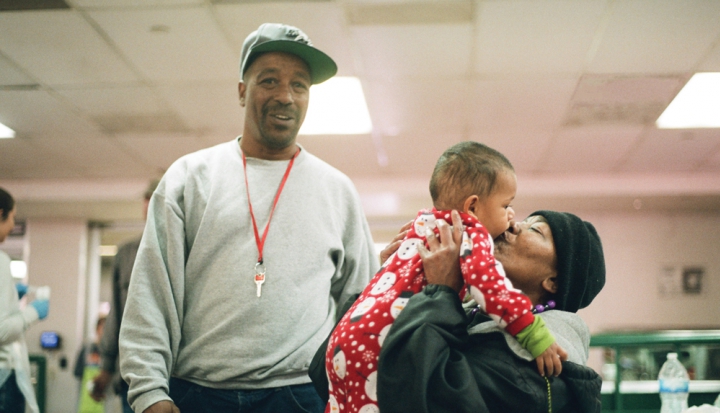It starts with a dusty, gray lump of coal. The animated character waves at others as they pass her on the street, but she is met with scorn or indifference, cast aside. Until she sees yellow hearts of light coming toward her, leading her into a church building where other rocks are gathered around in community. She’s embraced, and a little of the brightness underneath her dirty exterior starts to shine through. The character, named NiCoal, transforms into a sparkling diamond with the love she finds—and she shares her light with the world.
“Shine” is the name of this innovative short film, created by San Diego integrated marketing agency i.d.e.a. and Dallas-based animation studio Reel FX for Father Joe’s Villages—one of San Diego’s largest homeless services providers. Father Joe’s started as a small chapel serving impoverished people more than 65 years ago and has grown into a trailblazing provider of housing programs and services. This film is their way of challenging and reframing a big issue in San Diego, which has the country’s second-largest population of homeless people. “When society sees hopelessness and helplessness we see hope and potential,” says Deacon Jim Vargas, president and CEO of Father Joe’s Villages. They want to be sure that others in the community see that potential, too.
Father Joe’s affords housing for nearly 1,900 people each night and up to 3,000 meals every day, along with healthcare, clothing, education, job training, and much more. “We provide anything and everything an individual needs to get better,” says Vargas. “We want people to break the cycle and be able to be self-sustaining—a lot goes into that.”
Vargas isn’t exaggerating. Father Joe’s has a federal qualified health clinic because, as Vargas says, “you can’t get off the street with medical ailments plaguing you.” They have a relationship with the University of California-San Diego medical school that goes back 20 years, and clients of Father Joe’s get help not only with physical issues but also mental health, addiction, and dental repair or dentures, which Vargas notes are key when clients try to get a job. “The health side is very important—we want individuals to be able to have an income, and that comes from employment,” he says.
The Education Center provides clients with an opportunity to earn a GED, learn computer skills, work on resume-building and networking, and pick up donated professional clothes for interviews. “We canvas the market to see which jobs are in demand, and we focus our courses along those lines,” explains Vargas. The culinary arts program has produced local chefs, and the security guard and forklift operations programs have also created qualified applicants for high-demand areas.
Children, too, get interventional help at Father Joe’s. “If kids have developmental delays, we work with them from an early age so when they get to preschool they’re up to peer level,” Vargas says. “Statistics show that if they fall behind and that’s not mitigated, they’ll drop out of school and repeat the cycle.”
In short: It’s a full-scale operation, and Father Joe’s recognizes that there is no single solution to homelessness. Plus, they’re nimble. For example, when the health clinic opened and doctors gave out prescriptions, they realized people weren’t getting to CVS to fill them. So now they have a pharmacy on site.
One family’s story
Marlene Ayala knows all about the comprehensive programs at Father Joe’s. After losing her job at Walmart in 2010, she had exhausted her unemployment benefits by the middle of 2011 and was evicted from her home along with her husband and three children.
“The kids would sleep inside a friend’s house while my husband and I slept in their yard under a tent,” she says. After a couple of months, the family ended up in Tijuana with Ayala’s mother, crossing back to California at 3 a.m. and sleeping down the street from the children’s school until the day started. “In the morning we would go to the gas station so the kids could change, brush their teeth, and get their hair ready for school,” she says.
Ayala’s husband, Rodrigo, is a disabled veteran. “He remained the faithful one, visiting the chapel constantly for prayer and bringing us to Sunday Mass,” she says. The family heard about Father Joe’s through their church, and in November 2011 they were able to enter transitional housing through the VA homeless outreach.
While living at Father Joe’s Villages, the family participated in programs like the Therapeutic Childcare Center, where Marlene and Rodrigo took parenting classes and the kids had childcare that helped them with academics and social adjustment.
The Ayalas also took part in a savings program in which they put away 33 percent of their income and enrolled in a budgeting class. Through that work, the family was able to purchase a home of their own two years ago. “The people at Father Joe’s changed our situation in a huge way,” says Marlene. “They housed us, fed us, clothed us with donations, and provided our kids with gifts when we weren’t able to do it ourselves—the support was astonishing.”
Ambitious goals
Father Joe’s has big dreams for solving the homelessness epidemic, and the foundation of their work has always been finding homes for families like the Ayalas.
“We can point to the mental health issues or addiction and substance abuse, of course that’s sometimes there,” says Vargas. “But we’ve come to realize that in order to be able to get our arms around this and make a difference, what we need to do is focus on housing. We can provide all of the interventions mentioned, and that’s good, but at the end of the day if we don’t provide permanent housing for people, they’ll wind up on the streets again.”
To that end, Father Joe’s has launched the Turning the Key campaign, calling for the introduction of 2,000 affordable housing units in San Diego. It’s a half-billion dollar endeavor, but Vargas says it’s necessary. Father Joe’s owns some property in the city, so there is new construction happening there on 760 units. The other 1,240 will be provided through the acquisition of old, dilapidated motels that are being converted into housing.
“We hope to house 2,700 individuals in studios, one-bedrooms, and two-bedrooms,” says Vargas. “The initiative is substantial and audacious, but we are a leader and this is in keeping with that.” According to Vargas, there are public funds available to cover 75 percent of the cost, and Father Joe’s needs to raise $122 million in philanthropic donations.
To heighten public awareness, Father Joe’s seeks to change the conversation around homelessness and help people truly connect with the stories of families like the Ayalas. “We wanted a campaign that would call attention to the plight of the homeless—including how people ignore the issue or feel helpless,” says Vargas. “These individuals are just like us . . . ‘there but for the grace of God go I.’ We needed a call to action.”
An idea becomes art
The Father Joe’s team discussed this messaging challenge with i.d.e.a., and Jon Bailey, chief relationships officer at the agency, was passionate about the project from the start. “I was raised Catholic and part of my belief system is that it’s important for us to give back and participate in making our communities better,” he says. “[Our agency] comes from that place, that heart.” Bailey says that everyone at i.d.e.a., all 30+ employees, stepped forward to say they wanted to be a part of the Father Joe’s campaign. “Everyone asked, ‘What can I do?’ ”
Their work started with research. The i.d.e.a. team took a tour of Father Joe’s and learned about the services offered. They pitched in, too—going through a mountain of donated items and organizing them alongside Father Joe’s employees. “The people there make a difference every day,” says Austin Bousley, i.d.e.a.’s creative director. “They have open arms for anyone who’s experiencing homelessness, who needs a place to sleep, a meal to eat, a path to job placement—because they see things that others don’t.”
Additionally, i.d.e.a. looked at what similar organizations were doing with campaigns to combat homelessness. “What we saw was a lot of dark and sad materials that are used to shock,” Bousley says. “But we wanted to go visceral—make people feel something and turn that emotion into stepping up and contributing.”
In focus groups, the agency asked people about their reactions to seeing homeless people on the street. “Hopelessness was the response,” says Bailey. “They stopped seeing people, and instead of seeing someone’s son, someone’s sister, or a person, they saw someone to avoid.” i.d.e.a. called the Father Joe’s campaign “We See,” because the philosophy that they live by is that they see the individual; they see the person through all the trauma and discomfort. And when someone feels seen, they can start to change and solve some of their problems.
“People, including myself, have grown familiar with the homeless population,” says Bousley. “You see homelessness every day, it becomes part of your routine, and you stop thinking about it. You don’t stop caring, but it slips to the back of your mind.” The i.d.e.a. team realized that to bring in a new generation of donors, they had to do something different: They had to present hope.
“The short film is a side door to get the audience to feel sympathy and to realize there is potential in every person you meet, that we’re all the same deep down,” says Bailey. “If we can tie that to Father Joe’s mission, then we’ve done our job.”
The short film that shines
“Shine” was nominated in the Global Consciousness category at the San Diego International Film Festival, and Father Joe’s has been thrilled with the way it’s been received by both their current community of givers and the new folks being brought in. “In just three minutes, this heartwarming film demonstrates the power of compassion to transform a life,” says Tonya Mantooth, executive and artistic director of the San Diego International Film Festival. Vargas simply says, “People are touched by it.”
That, for i.d.e.a., was the goal. “We reached the point in people’s hearts that they had closed off to this issue,” says Bailey. “When it played at the Father Joe’s annual gala, there were tears. The film moved and motivated a lot of people.”
The yellow hearts of light that feature prominently at the end of “Shine” have become an icon for Father Joe’s, repeated and brought to life in various ways on their website and in literature. And this fall, hundreds of people joined A Short Walk Home—a walk to raise funds and awareness for neighbors who are homeless—and each participant carried a yellow heart-shaped balloon.
Marlene Ayala believes that art has the power to move people to action. “We can reach out to our community in regards to homelessness in many different ways,” she says. “I do believe that the homeless epidemic has been put into a negative spotlight . . . but art, music, skits, and short films can educate people.”
Bailey confirms that the film has affected donations in a positive way, reaching a younger audience than their donors had been previously. “Part of the research we uncovered is that Millennial audiences are wired to give more than any other generation,” says Bailey. They may not have as many resources as older generations yet, but they’re more likely to donate if you can reach them, and in that category and age group, Father Joe’s has found new donors.
The i.d.e.a. team notes that everyone who worked on the project has been changed in some way. “I shifted my perspective just walking down the street,” says Bailey. “I interact with homeless people, looking them in the eye and saying good morning—it’s a respectful way to recognize that that’s a human being.”
This article also appears in the January 2018 issue of U.S. Catholic (Vol. 83, No. 1, pages 24–28).
Image: courtesy of Father Joe’s Villages














Add comment